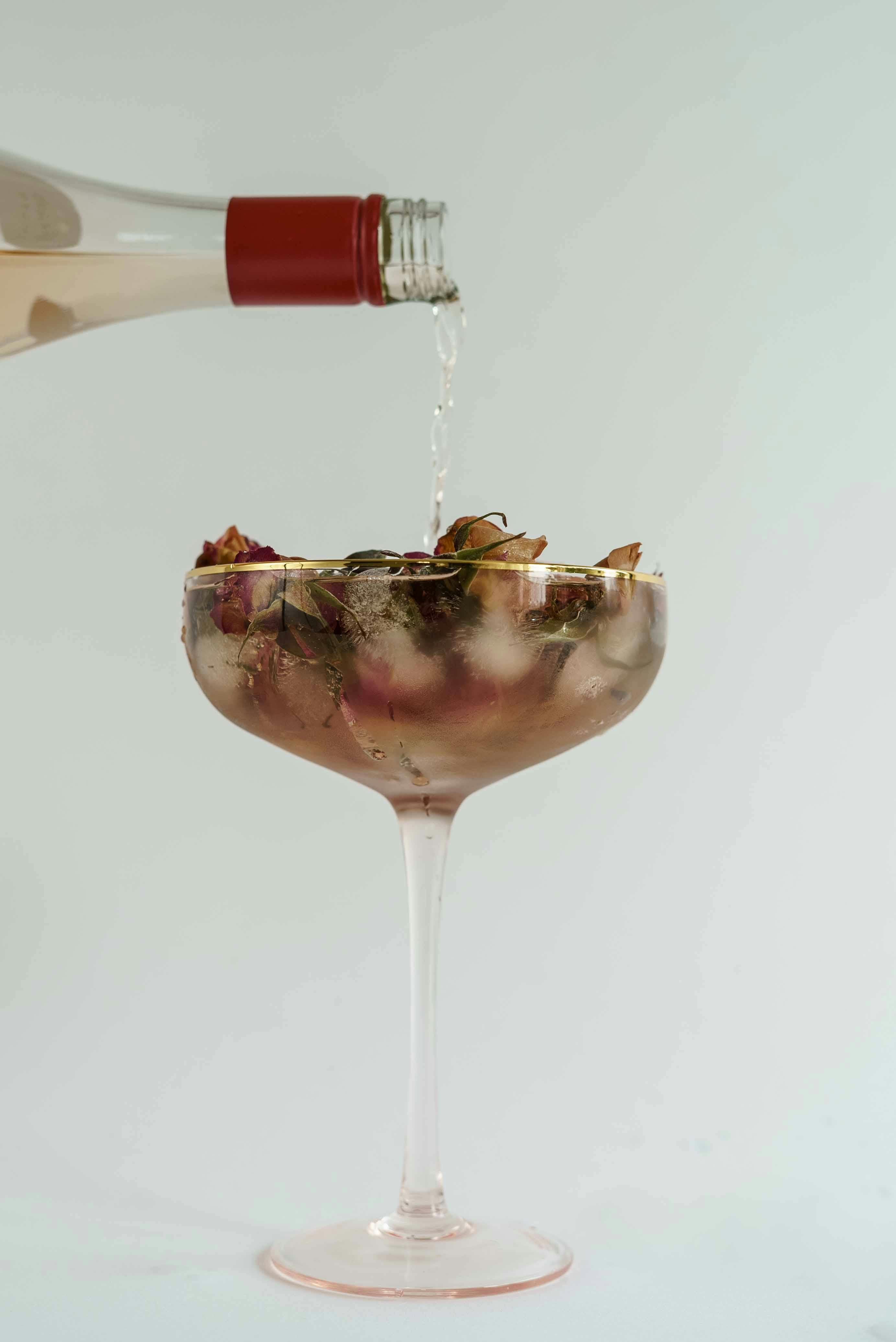Ice wine is a unique and delicious dessert wine that should be stored and served differently than other wines. It is important to understand how to properly store and serve ice wine in order to ensure that its quality and flavor are not compromised.
Ice wine should be stored at a cool temperature, preferably between 6-8 degrees Celsius. This allows the wine to maintain its optimal flavor and aroma. It is also important to store the ice wine in a dark place away from light sources, as light can cause the flavor of the wine to deteriorate. Additionally, it should be stored in an upright position so that the cork doesn’t dry out or become moldy.
When serving ice wine, it should be served chilled but not cold. The ideal temperature for serving ice wine is between 4-6 degrees Celsius and should be served in smaller glasses than traditional wines. This type of glassware helps to concentrate the aromas of the wine, allowing you to enjoy it even more.Ice wine, also known as icebox wine or Eiswein, is a type of dessert wine produced from grapes that have been frozen while still on the vine. Ice wines are typically sweet and high in acidity. They are made from a variety of grape varieties including Riesling, Vidal, Cabernet Franc and more.
To produce ice wine, the grapes are harvested late in the season when temperatures begin to drop below freezing. The grapes must be picked and pressed within 24 hours of harvest to ensure that enough water has frozen within the grape cells to concentrate flavor and sweetness. After pressing, the juice will ferment for several months before bottling.
Ice wines tend to have an intense flavor profile with notes of honey, peach, lychee and apricot. They can range in color from pale yellow to deep golden hues and have very high sugar content due to their natural concentration of flavors. Ice wines can be enjoyed as an aperitif or as a dessert accompaniment with rich cheeses and other desserts.
Contents
How Is Ice Wine Produced?
Ice wine production is an interesting process that requires the right conditions to occur in order for it to be successful. The grapes used for ice wine are left on the vine until they freeze naturally. This usually happens around late December or early January, depending on the climate. Once the grapes have frozen, they are harvested and quickly pressed while still frozen. As the water content in the frozen grapes is very low, pressing yields only a small amount of intensely flavored and concentrated juice. After pressing, fermentation takes place until the desired level of sweetness is achieved. The finished product is a sweet and highly aromatic dessert wine that has flavors of honey, apricot and peach.
The process of producing ice wine is quite labor intensive and requires patience. Due to its limited production, it is often more expensive than other types of wines. But it’s worth it: when done correctly, ice wine can be a sweet and special treat!
Types of Ice Wine
Ice wine is a sweet, dessert-style wine made from grapes that have been frozen while still on the vine. It is a specialty wine that requires a unique set of conditions and can be made in a variety of styles. The most common types of ice wine include German Eiswein, Austrian Eiswein, Canadian Icewine, and French Vin de Glace.
German Eiswein is produced from grapes that have been naturally frozen on the vine. The grapes must be harvested by hand at temperatures below 17°F (−8°C). It has an intense sweetness and aromas of honey, flowers, apricots, and citrus fruits.
Austrian Eiswein is also produced from naturally frozen grapes that are harvested by hand when temperatures reach 19°F (−7°C). It has a rich flavor profile with notes of honey, apricot, mango, apple, and lychee.
Canadian Icewine is made from Vidal Blanc or Riesling grapes that have been frozen on the vine when temperatures reach −8°C (17.6°F). It has a unique aroma reminiscent of honey and apricots with flavors of lychee and tropical fruits. Canadian Icewine typically has higher sugar levels than other ice wines due to the colder climate in Canada.
French Vin de Glace is made from Muscat or Chardonnay grapes that are harvested at around −6°C (21°F). This type of ice wine tends to be less sweet than other varieties with aromas of ripe fruit and flavors of peaches and honey.
What Does Ice Wine Taste Like?
Ice wine is a unique and luxurious dessert wine made from frozen grapes that have been left on the vine for a longer period of time than other varieties. The result is a sweet, syrupy dessert wine with an intense flavor. Ice wine tastes like a combination of honey and ripe stone fruits such as apricots, peaches and nectarines, with notes of citrus zest and mineral. It is usually served chilled and pairs nicely with many desserts such as fruitcakes, panna cotta and crème brûlée.
Ice wine also has a noticeably high acidity due to the sugars concentrating during the cold weather. This creates a balanced sweetness that is surprisingly refreshing despite its rich flavor profile. Its aroma can range from floral to tropical fruit notes, depending on the variety of grape used in the making of the ice wine.
Overall, ice wine is a unique type of dessert wine that can be enjoyed as an after-dinner drink or paired with certain dishes to enhance their flavors. Its intensely sweet yet balanced taste makes it an excellent choice for those who enjoy sweet wines but are looking for something more complex than just sugary sweetness.
How Should Ice Wine Be Stored?
Ice wine should be stored in a cool, dark place such as a wine cellar or refrigerator. The ideal temperature is between 10 and 13°C (50 to 55°F). It should also be stored in an upright position to prevent the cork from drying out and letting air into the bottle. The humidity level should also be around 50-80%, as this will help keep the cork moist.
It is important to store ice wine away from direct sunlight, as UV rays can affect its taste and quality. Additionally, it should not be stored near strong odors, such as paint or cleaning products, as these may also affect its flavor. Ice wine has a shelf life of 7-10 years when properly stored, but it may last longer depending on the variety and vintage.
Ice wine is best enjoyed soon after opening; however, if you do not plan to drink it right away, make sure to store any leftover bottles in the refrigerator for up to three days. If kept longer than that, the flavor may start to change due to oxidation.

What Is the Optimal Serving Temperature for Ice Wine?
Ice wine, also known as Eiswein, is a specialty dessert wine made from frozen grapes. It has a distinct sweet flavor and is usually served very cold. To get the most out of an ice wine, it’s important to serve it at the optimal temperature. The ideal serving temperature for an ice wine is between 5°C and 8°C (41°F and 46°F).
Serving ice wine at too low of a temperature can mute its flavors and aromas, while serving it too warm can make it taste overly sweet. For best results, chill your ice wine in the refrigerator for about an hour before serving. This will allow the flavors to fully develop and give you the most enjoyable experience possible.
It’s also important to remember that each type of ice wine has its own optimal serving temperature. For sweeter styles of ice wine, a slightly higher temperature may be preferable as it will bring out more of the fruity flavors. For drier styles, however, a lower temperature is advised so that the subtler notes can be more easily enjoyed.
When it comes to serving ice wine, the key is to experiment and find what works best for you. Try different temperatures and see which one brings out the best in your favorite bottle of Eiswein. With a little bit of trial and error, you’ll soon discover what makes your perfect glass of ice wine!
How Do You Open an Ice Wine Bottle?
Opening an ice wine bottle is a bit different than opening a regular wine bottle. The special structure of the bottle requires special care when opening it. Here are the steps to open an ice wine bottle properly:
1. Make sure the bottle is chilled – Ice wines should be served cold and stored in a refrigerator or in a cool cellar for optimal taste.
2. Remove the foil capsule – Use a sharp knife to cut around the top of the bottle, just below the lip of the bottle neck.
3. Place your thumb over the cork – Make sure your thumb is placed firmly over the cork to prevent it from popping out unexpectedly.
4. Twist off the wire cage – Using one hand, grip the wire cage and twist off while holding onto the cork with your other hand.
5. Remove the cork gently – Once you have removed the wire cage, slowly twist and pull out the cork to release any built-up pressure within.
6. Enjoy! – Pour yourself a glass of delicious ice wine and enjoy!
Glassware is Best for Serving Ice Wine
Ice wine is a unique and luxurious dessert wine that requires special care when it comes to serving. The type of glassware you choose for serving ice wine can make a big difference in the experience. It’s important to select the right glassware so that you can get the most out of your ice wine. Here are some tips for choosing the best glassware for serving ice wine:
Size: Ice wine should be served in smaller glasses, as it is a very concentrated and sweet wine. A standard white or red wine glass will hold too much, and the aromas and flavors of the ice wine will be lost due to over-serving. The ideal size for an ice wine glass is 5-6 ounces.
Shape: The shape of your glassware also plays an important role in enjoying ice wines. Opt for glasses with narrow bowls and tapered rims, as these help concentrate and funnel aromas towards your nose while keeping the sweetness of the ice wine in balance.
Material: Crystal or leaded crystal glasses are ideal for serving ice wines, as they not only look beautiful but also enhance the flavor and aroma of this delicate dessert wine. Lead-free crystal glasses are also available which are just as good as leaded crystal, but without any of the health risks associated with lead exposure.
No matter what type of glassware you choose, remember that it should be able to contain just enough ice wine so that you can appreciate its complex flavors and aromas without over-serving or wasting any precious drops!

Conclusion
Ice wine should be stored in a cool, dark place with constant temperatures around 8 – 10°C (46-50°F). For optimal flavor, ice wine should be served chilled at a temperature of 10°C (50°F). The bottle should also be opened no more than one day before serving and it should always be consumed on the same day. Ice wine can also be served as an aperitif, or as an accompaniment to light desserts such as fruit tarts or sorbet. With proper storage and serving instructions, anyone can enjoy the unique flavor of ice wine.
When looking for a quality ice wine, look for an established producer that has been producing it for many years. It is also important to pay attention to the vintage, since older vintages tend to have higher sugar levels and more balanced flavors. Finally, remember that ice wines are best enjoyed when shared with friends and family.
0 Comments